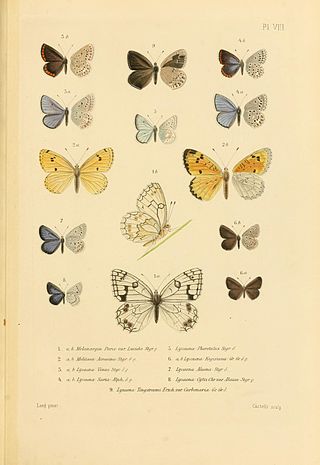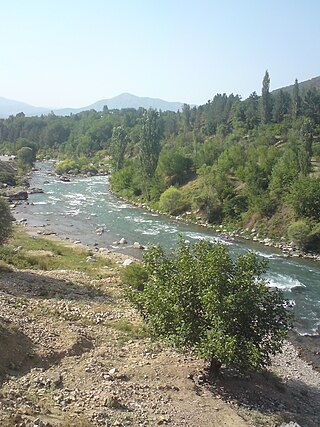
The Alay or Alai Range is a mountain range that extends from the Tien Shan mountain range in Kyrgyzstan west into Tajikistan. It is part of the Pamir-Alay mountain system. The range runs approximately east to west. Its highest summit is Pik Tandykul, reaching 5544 m. It forms the southern border of the Fergana Valley, and in the south it falls steeply to the Alay Valley. The southern slopes of the range drain into the Kyzylsuu or Vakhsh River, a tributary of the Amu Darya. The streams that drain the northern slopes of the range are tributaries of the Syr Darya, and empty into the Fergana Valley to the north of the range. Pik Skobeleva, 5,051 metres (16,572 ft), is also a well-known summit. European route E007: Tashkent – Kokand – Andijan – Osh – Irkeshtam crosses the range by the Taldyk Pass. The range is also traversed by Pamir highway.

The Mountains of Central Asia are a biodiversity hot spot designated by Conservation International which covers several montane and alpine ecoregions of Central Asia, including those of the Pamir and Tian Shan ranges, and extending across portions of Afghanistan, China, Kazakhstan, Kyrgyzstan, Tajikistan, Uzbekistan and the Karakoram range in China, Pakistan and India. The Karakoram range is also famously known for Karakoram Anomaly that relates to the anomalous growth of glaciers in the central Karakoram that is in contrast with melting glaciers in other mountainous ranges of Himalayas and other parts of the world due to the effects of climate change.

Parnassius apollonius is a member of the snow Apollo genus Parnassius of the swallowtail family, Papilionidae. It is found in central and south Kazakhstan, the south Altai, Saur, Tarbagatai, Dzhungarsky Alatau, Tian-Shan, Ghissar-Darvaz, the Pamirs-Alai and west China.

Polyommatus eros, the Eros blue or common meadow blue, is a species of blue butterfly found in the Palearctic.

Plebejus is a genus of butterflies in the family Lycaenidae. Its species are found in the Palearctic and Nearctic realms.

Boloria is a brush-footed butterfly (Nymphalidae) genus. Clossiana is usually included with it nowadays, though some authors still consider it distinct and it seems to warrant recognition as a subgenus at least.

Athamanthia is an Eastern Palearctic genus of butterfly in the family Lycaenidae. Athamanthia is differentiated from Lycaena by characters of the male genitalia.

Muschampia is a Palearctic genus of spread-winged skippers in the family Hesperiidae.

Melitaea arcesia, the blackvein fritillary, is a butterfly of the family Nymphalidae. It is found from southern Siberia and Transbaikalia to the Amur region, Mongolia and China. The habitat consists of steppe-clad slopes.

Melitaea arduinna, or Freyer's fritillary, is a butterfly of the family Nymphalidae. It is found from south-eastern Europe across Asia Minor to central Asia and the Altai. The habitat consists of steppe-clad slopes.

Melitaea persea is a butterfly of the family Nymphalidae. It is found from Iran and Asia Minor to Afghanistan and the western parts of the Tian Shan mountains.

Colias thisoa is a butterfly in the family Pieridae. It is found in the mountains of the Caucasus, Transcaucasia, central Asia, southern Siberia, Turkey and Iran. The habitat consists of humid mountain meadows in the forest belt.

Arctia intercalaris is a moth of the family Erebidae. It was described by Eduard Friedrich Eversmann in 1843. It is found in Dzhungarian Alatau, Zailiiskii Alatau, Tien Shan, Alai-Pamirs, Uzbekistan, Kyrgyzstan, Tajikistan, the mountains of Afghanistan, north-western Pakistan and from Kashmir to Kulu.
Polygonia undina is a butterfly of the family Nymphalidae first described by Grigory Grum-Grshimailo in 1890. It is found from Ghissar-Darvaz to the Pamirs-Alai and Tian-Shan in north-western China and the Himalayas.

Polygonia interposita is a butterfly of the family Nymphalidae. It is found from Ghissar to the Altai Mountains, north-western China, the Himalayas and Mongolia. The habitat consists of gorges and slopes up to 2,500 meters above sea level.

Agriades pheretiades, the Tien Shan blue, is a Palearctic butterfly of the family Lycaenidae.

The Alai-Western Tian Shan steppe ecoregion covers the foothills on the western edge of the Tien Shan and Alay Mountains of Central Asia. This territory is mostly in southeastern Uzbekistan, with a portion running north into Kazakhstan on the east side of the Syr Darya River, and a small portion in Turkmenistan.

The Gissaro-Alai open woodlands ecoregion covers the western foothills winding around two western offshoots of the Tian Shan Mountains in western Tajikistan, and parts of eastern Uzbekistan and western Kyrgyzstan, in Central Asia. The woodlands are typically of Juniper trees and shrubs, fitting the altitude zone situated between the desert valley floor, and the tree line, above which the mountain ridges are glaciated and barren.

















